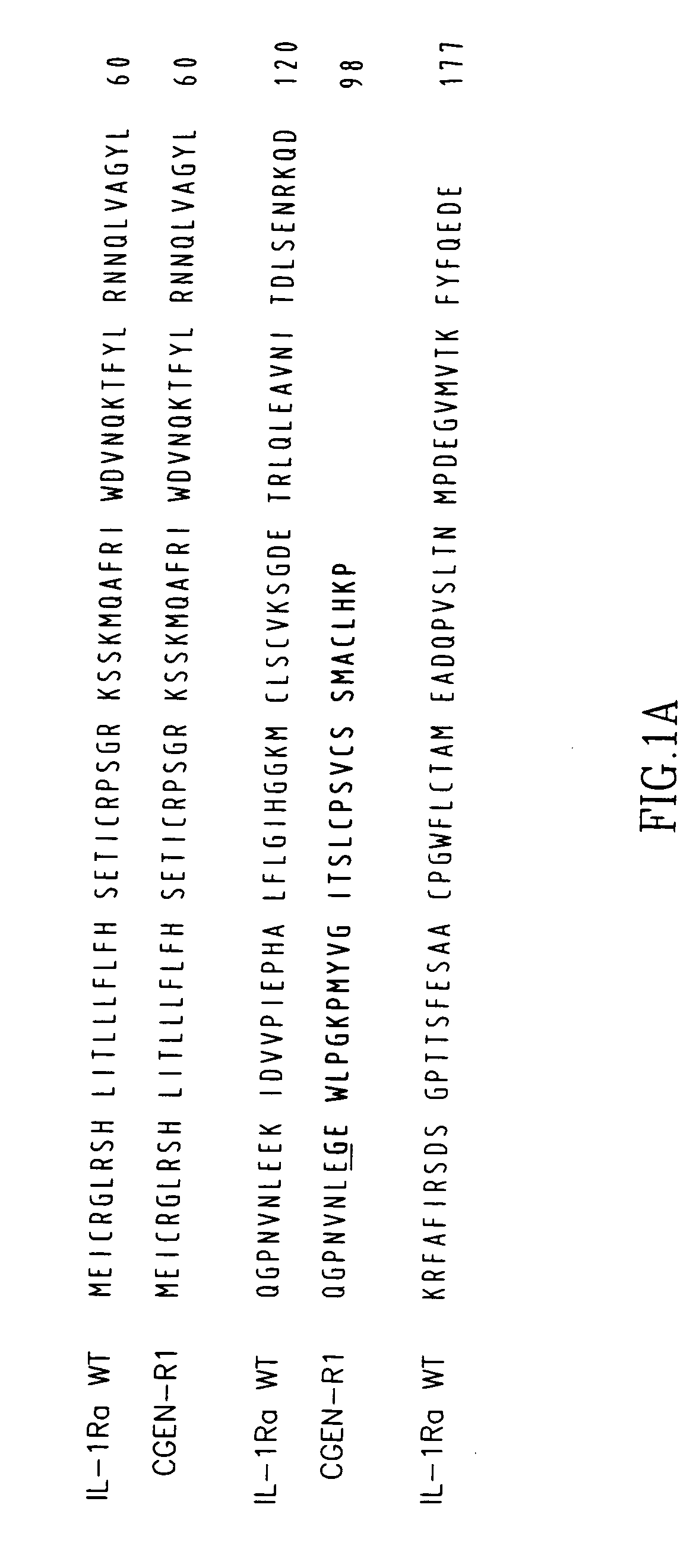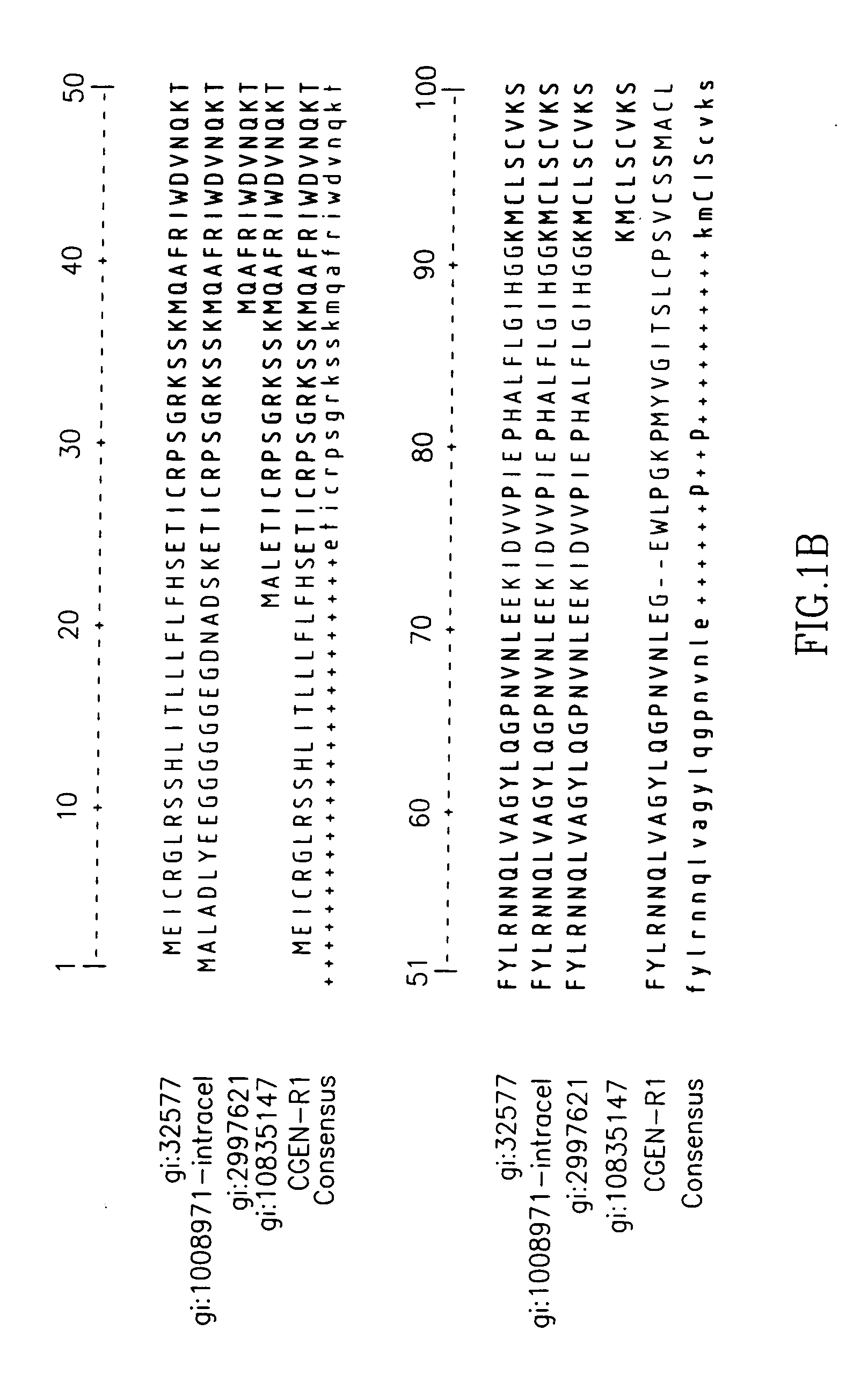Variants of interleukin-1 receptor antagonist: compositions and uses thereof
a technology of interleukin-1 receptor and variant, which is applied in the preparation of animal/human proteins, sugar derivatives, peptide preparation methods, etc., can solve the problems of inflammatory damage, pulmonary hypertension and further secondary damage, and vascularization of capillaries. and vascularization
- Summary
- Abstract
- Description
- Claims
- Application Information
AI Technical Summary
Benefits of technology
Problems solved by technology
Method used
Image
Examples
example 1
Identification of CGEN-R1
[0280] The mRNAs sequences of the known IL-1Ra (SEQ ID NO:7) and its variants (SEQ ID NO:14; SEQ ID NO:12; SEQ ID NO:13), were used for screening an EST database for novel splice variants using proprietary algorithm for clustering and assembly of nucleic acid sequences (the method for mRNA clustering and assembly used described in U.S. patent application Ser. No. 09 / 133,987. The screening and annotation method described-in U.S. patent application Ser. Nos. 10 / 426,002, 10 / 242,799 assigned to the assignee of the present invention). Three types of EST clones were revealed: [0281] (i) An EST clone containing part of exon 1 and exon 2 joined to a unique sequence, derived from an intron 2 of the wild type IL-1Ra (SEQ ID NO:7). This EST was identified in a human cDNA library NIH_MGC—120 (Pooled Pancreas and Spleen, Accession number B1836973). [0282] (ii) Four EST clones with high homology to the above unique intron-derived sequence were found to be transcribed, wi...
example 2
Expression of the Novel CGEN-R1 Splice Variant
[0286] The expression of the novel CGEN-R1 splice variant was examined by RT-PCR in the following tissues and conditions: Crohn's inflammatory colon tissue, colon, spleen, bone marrow, liver, thymus, pancreas, melanoma cell line.
[0287] The following primers (schematically described in FIG. 3) were used for the RT-PCR:
Primer 1:IL-1Ra Variant flanking exon F:CAGAGGCCTCCGCAGTCACC.(SEQ ID NO:15)Primer 2:IL-1Ra Variant flanking exon R:TGACGGGCTGGTCAGCTTCC.(SEQ ID NO:16)Primer 3:IL-1Ra Variant specific F:GGCAGCCTGAAGAGGGTGTGG.(SEQ ID NO:17)Primer 4:IL-1Ra Variant specific R:TCCCACTGAAGGGAAAGCTGAGG.(SEQ ID NO:18)
[0288] The RT PCR conditions were as follows: the reaction mixture contained in a final volume of 25 μl: 0.5 μl of specific primers, 25 μM; 1 μl of cDNA; 2.5 μl of 10× reaction buffer (Qiagen); Hotstar Taq polymerase (Qiagen) 0.5 μl; dNTPs (Takara) 2 μl of 5 mM each. The RT-PCR was performed with 1 cycle of 15 minutes at 95° C., fol...
example 3
Cloning of the Variant
[0290] mRNA from normal liver and spleen (sample # 081P0101A—from AMBION) was isolated and subjected to reverse transcription (RT) using random hexamer primer mix and Superscript™, followed by a treatment of RNAse I. The wild type IL-1Ra and the CGEN-R1 novel splice variant fragments for cloning were prepared by PCR amplification using TaKaRa Hot-Start Ex-Taq™ under the following conditions: 2.5 μl—Ex-Taq X10 buffer; 5 μl—cDNA; 2 μl—dNTPs (2.5 mM each); 0.5 μl—Ex-Taq enzyme; 14 μl—H2O; and 0.5 μl—of each primer in a total reaction volume of 25 μl; with a reaction program of 5 minutes in 95° C.; 40 cycles of: 30 seconds at 94° C., 45 seconds at 68° C., 60 seconds at 72° C. and 10 minutes at 72° C.
[0291] The following primers, comprising specific sequences of the nucleotide sequence corresponding to the splice variant and / or the wild type, and Gateway™ BP recombination tails were used:
Primer 5:IL-1Ra forward primer with a signal peptide(SEQ ID NO:19)5′GGGGACA...
PUM
| Property | Measurement | Unit |
|---|---|---|
| melting temperature | aaaaa | aaaaa |
| temperature | aaaaa | aaaaa |
| temperature | aaaaa | aaaaa |
Abstract
Description
Claims
Application Information
 Login to View More
Login to View More - R&D
- Intellectual Property
- Life Sciences
- Materials
- Tech Scout
- Unparalleled Data Quality
- Higher Quality Content
- 60% Fewer Hallucinations
Browse by: Latest US Patents, China's latest patents, Technical Efficacy Thesaurus, Application Domain, Technology Topic, Popular Technical Reports.
© 2025 PatSnap. All rights reserved.Legal|Privacy policy|Modern Slavery Act Transparency Statement|Sitemap|About US| Contact US: help@patsnap.com



